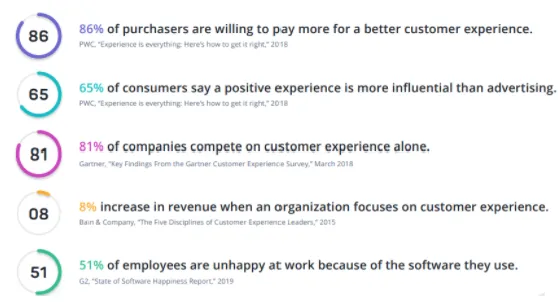The focus on software quality has shifted so much from making sure your product “works” to making sure it “doesn’t break” that the customer experience of actually USING the software is frequently disregarded. Automated testing ensures that all buttons make the proper API calls, but it can’t really tell you if your software workflows are unclear to users or if they need guidance from implementation experts in order to use the product effectively.
The data can speak for itself:

What therefore can we as testers do to ensure that this also becomes a priority for our company and that customer experience is incorporated into our overall quality strategy?
Solution: Marketing Knowledge Will Improve Your Testing
Say what? What does testing the user experience have to do with marketing, you might be asking. As if our jobs as testers weren’t already demanding enough. In any case, it’s not the testers that are in control of this. All of these ideas are accurate, but if our organizations are sincere about providing our consumers with exceptional user experiences, we in QA need to be aware of the messages our products are conveying. It is our responsibility to continue to lead these discussions throughout the development process so that the customer’s perspective is heard PRIOR to moving to the competitors, who may have thought about it. How to communicate with the target audience, convey a message, and sway behavior are all aspects of marketing. It appears that QA can pick up on similar methods for interacting with customers and influencing organizational behavior to prioritize the end user experience.
The A, B, C and D of Marketing: How It’s Done
This is one way QA can zero in on the client experience.
A: Audience
Sending your message to your target audience is essential in marketing. Similarly, if you can’t understand your software’s end user, you won’t be able to comprehend how they feel about the product’s quality. There should be no question that the type of audience we are addressing matters based on the people we are serving with our products. Testers should be aware of whether we are developing a solution for a hospital emergency room or a food kiosk for an airport. The audience for whom we are designing our product is crucial to how that audience will assess its quality. How then should we address the crowd? User narratives. Go deeply into those user stories and delve even further into the potential user personas. Asking your product owners many hypothetical questions can help you identify every scenario that needs testing. In-depth analysis of WHO is obtaining what VALUE from this feature/functionality is also crucial. The testers’ attention will be kept on the perceived product quality from the end customers’ perspective if they concentrate on the PEOPLE who benefit from the product.
B: Behavioral goal
Marketing teams’ primary goal is to alter consumer behavior; they are not just out there spouting words and visuals. In software, the true return on investment that the corporation seeks to achieve is the agreed-upon change in behavior that the application delivers. What evidence enables the business to conclude that the application is having a significant impact? For testers, this means coordinating the customer experience with the general aims and objectives of the business. When it comes down to it, quality is frequently just a matter of whether the customer accepts the expectations that marketing and sales have established for them after receiving the product. This, in my opinion, is the essence of an organization’s overall quality. The understanding of this alignment in the user stories, test plans, and acceptance criteria of our testing activities is crucial for testers.
C: Content
Giving you an RTB—Reason to Believe—is one of the key objectives of content in a marketing communication. You will find the motivation from an RTB to make that buy or to alter your present consumer habits. You receive the same material while utilizing a software product in an excellent customer experience. Testers must make sure that the product contains the following content: reports, logs, audit trails, appropriate documentation, and cyber security verifications. When a feature was thought of as part of the user experience, the consumer won’t need to use another third-party reporting provider. Alternatively, you won’t require a totally disengaged learning management system to adequately understand how to operate the product. These factors must be taken into account during the test plan phase or included in the Epics, Features, and Stories acceptance criteria. The consumer need RTB that the product lives up to all the promises made by the sales and marketing teams. If a product doesn’t easily provide all the RTB to the customer, they will choose another one that does in order to match the sales and marketing objectives.
D: Deliveries
In order to reach the target audience most effectively in marketing, it is important to determine WHERE they will be when they are present. Where our customer connects with our application is important in software. It is important for testers to consider if the application’s value is being correctly communicated through that device. Has the same information been correctly modified for the various platforms to optimize customer satisfaction? Here, the product’s quality and the promise it makes are combined. It is exceedingly unlikely today that your product is supplied solely through one medium (a desktop computer). The majority of people on the earth today use their most portable and private gadgets, smartphones, to consume applications of all kinds. Customers anticipate that the program will work with the limitations of the screen size and access device they choose. Mobile screens, for instance, are smaller and frequently used in shorter bursts. (2022; www.colorblindawareness.org) A quality user experience may be attained by making sure your product is valuable regardless of where or by whom it is used.





Recent Comments